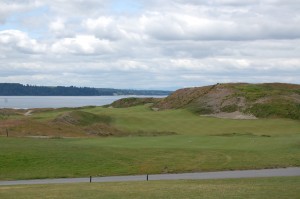(With the U.S. Open starting June 18, Golferswest.com will re-publish many of the stories our writers have written of the course over the past months and years. This one deals with some of the unique aspects of Chambers Bay)
UNIVERSITY PLACE, Wa. – So much terrain is available at Chambers Bay golf course, site of the 2015 U.S. Open, that two holes will be played both as a par-4 AND a par-5 during the four-day tournament.
Among the changes being made at the links course located southwest of Tacoma are additional tees at No. 1 and No. 18, turning 500-plus yard par-4 holes into 600-plus yard par-5 holes from one round to the next.
“To my knowledge, the answer is ‘no’ ”, said USGA Executive Director Mike Davis when asked if any previous U.S. Open had holes with differing pars. “The Open goes back into the 1800s, but I would be very surprised if it happened. I think it is fair to say that this is the first time.”

With a new tee back near the putting green, Chambers No. 1 will be played as a par-4 and a par-5 during the Open.
A new tee area has not yet been built on No. 1, but Chambers Bay general manager Matt Allen said it would be located in a spot near one of the putting greens located not far from the snack shack and restroom facilities. The par-5 tee on No. 18 will be located several yards south of the par-3, 17th green.
“The genesis of doing this really kind of started with the 18th hole,” Davis said. “The more time I spent at Chambers Bay the more I realized that (No. 18) has tremendously interesting architectural features that allows it to be played both as a par-4 and a par- 5.
“It starts right in the drive zone,” he added. “If you play it as a par-5, it brings certain bunkering into play off the tee, but if you play it as a long par-4, it has some other really interesting attributes. If you can hit it long enough down the left side, you can actually carry the left bunker that sticks out. If you hit the downslope, you could get 50- to 70- yards of roll versus if you play it safer down the right side. In that case, you don’t get that kind of roll. There actually is a cross bunker way out on the right side, so if you are downwind and (the fairway) is firm, you could knock it in the bunker.”
Speaking of bunkers, there’s a new hazard on the 18th fairway, one that figures to come into play more often when the hole is played as a par-5.
“The design of the green at 18 is such that there are some hole locations that you say to yourself, ‘this really needs to be a par-5’ because hole location makes it so difficult – such as sitting up on a ridge,’” Davis said.
When the hole is played as a par-4, most drives will come up well short of the middle-fairway pot bunker, but pin placement could go a long way in deciding the ’15 U.S. Open champion.
As for No. 1, which currently measures 498 yards from the back tees, information gathered from the U.S. Amateur Championship — played in 2010 – led to that hole becoming a potential par-5, as well as a par-4.
“We quickly learned that while we played it as a long par-4,” Davis said, “there were some hole locations, like the front left, where it’s a wonderful risk-reward shot. But y0u don’t want to be hitting a long club into it. If you are, you are hoping that it’s your second shot on a par 5. I guess that’s what got me to thinking about making it a par-5.”
One of the coolest things about Chambers Bay is the flexibility it allows.
“Courses that have longer overall averages, like Chambers Bay, give us more flexibility on our setup,” Davis said. “At Chambers Bay, there is room to really play a lot of the holes different ways. We may do that because of strategy, hole location or because of certain wind conditions.
“When we go to courses shorter in length, I think the Olympic Club this year was an example and certainly Merion next year, which will be under 7,000 yards. They provide wonderful tests of golf, but you don’t have as much flexibility on the setup.
“It’s not only the length but it’s also some of the design features the architects put in it. Some courses are more straightforward and there are others that offer more options to do things. There is some wonderful flexibility at Chambers Bay. The architects did such a great job.”
The game plan for the Open is to alternate the holes, playing one of them as a par-4 one day and a par-5 the next, making Chambers Bay a par-71 each day of the tournament. Davis said No. 4, at 568-yards, would be a par-5, along with No. 8, a 602-yard journey that has all kinds of trouble left and right of the fairway.
The U.S. Amateur played as a par-71, but in match play it didn’t matter as much.
“There is no magic to what a hole’s par is,” Davis said. “At end of the day, we’re going to give away the trophy to the player with the lowest score. Whether that person is 10-under par, or 10-over par, it really doesn’t matter. This idea of mixing up the 1st and 18th holes in terms of par, it has everything to do with trying to get the most out of what the architect has designed. I think that it really does get more out of both of the holes if you mix it up on different days versus trying to decide which way you want to go and have it the same every day.”





















